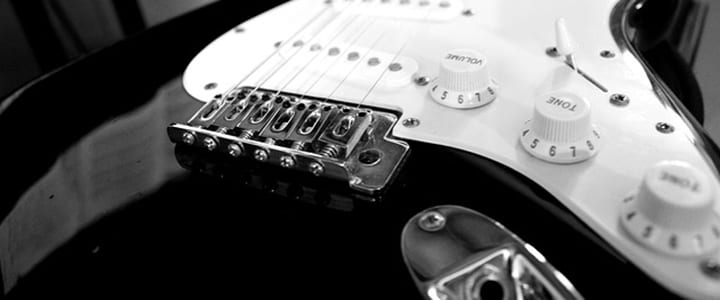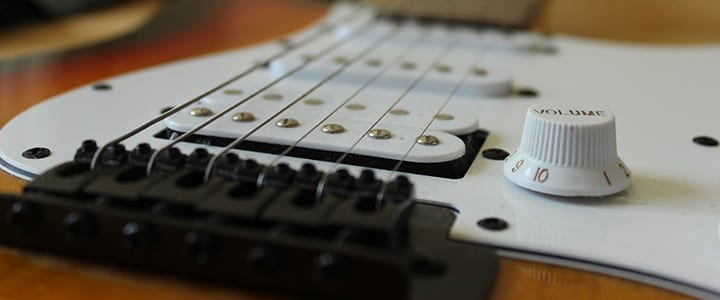Improve Your Guitar Tone Without Buying New Gear
By Team HC |
Improve Your Guitar Tone Without Buying New Gear
by Ben M.

When it comes to the electric guitar, players can be relentlessly dedicated to achieving the perfect guitar tone.
Guitar tone (also called guitar sound) is most simply defined as the sound your guitar produces. Guitar tone can be compared to a painting; it is a masterpiece that results from blending different colors together.
In this case your colors are bass, treble, mids, your amplifier, and any effects a guitarist may use.
Guitarists pride themselves on their tone because it is what sets them apart as an artist and gives them their own unique sound.
But don’t be fooled by this brief definition, guitar players can spend countless hours, days, and even weeks carefully sculpting their ideal tone.
However, the good news is that guitar tone is in fact 100% personal and every player, no matter how experienced, has the ability to dial in great guitar tone without spending a fortune on fancy gear (though it is important to have the essentials).
This article focuses on simple ways to improve your tone by simply using all the built-in features your electric guitar already has.
First Steps to Improve Your Guitar Tone
When beginning to work on improving your tone it is important to ask yourself a few basic questions:
– What aspects of my current tone do I like?
– What aspects do I dislike? (too dark, too bright, etc)
– Based on my playing style and genre, what aspects of my playing do I want to highlight in my tone (for example: sparkling chords, thick power chords, or clear solo bends)
After analyzing what you’ve discovered, set a goal. Maybe you are trying to imitate your favorite guitar idol’s tone or want to focus on creating your own sound.
Regardless of what your goal is, an important thing to keep in mind (especially for beginners) is to always start with what you have.
How to Use Your Guitar Tone Settings
While many players may rush to their local music store and walk out with a handful of effects pedals or even a new amp, most players tend to forget one of the most basic aspects of their guitar’s anatomy; the pickup selector switch and the tone and volume control knobs.
Below is a quick breakdown of an electric guitar’s tone settings:
Pickup Selector Switch
Selects which pickup is active on your guitar. Most guitars have three switch positions; some guitars like Fender Stratocasters have five.
Bridge Pickup (farthest down): bright, sparkling sound, lots of treble
Middle Position: warm and shimmery sound, high mids
Neck Pickup (farthest up): full and rounded sound, more bass
Volume Control
Controls the master volume of your guitar, or the amount of signal that will come out of your amplifier.
Tone Control
Controls the brightness or darkness of your guitar’s sound by adding or reducing the amount of bass/treble in the signal.
Bass = darker tone with lots of low end.
Treble = brighter tone with lots of high end and sparkle.
How to Adjust Your Guitar Knobs for Better Guitar Tone
Now that we have established the basics, let’s focus on learning how to use the guitar knobs.
Players of all levels continue to leave their controls dialed up to 10 all the time, restricting them from loads of undiscovered tone possibilities. To make a comparison, that’s like buying a sports car and only driving it only in first gear.
A simple concept that can really help develop a guitar player’s control over their tone is getting into the habit of setting your tones with the volume and tone controls below their maximum levels.
When you dial in your tone with the knobs at 10, you have limited adjustment options. Only being able to turn down the knobs will typically make your sound muddy.
By giving the controls room to expand, you have an array of possibilities if your tone needs adjusting. Below are common ways to use your guitar controls and bring up your guitar playing IQ.
Guitar Knob Techniques
Basic Boost:
The volume knob can act as a boost which can take your guitar from clean sounds for rhythm playing to dirty overdrive tones for soloing. When playing a song keep your volume knob at 6 or 7 when playing chords or verse parts and when it’s time to deliver a rockin’ solo roll up the volume to 10 and you will not only hear a boost of gain (overdrive) but also a volume lift over any other instruments in the song.
Signal Clean Up:
Perhaps your tone is too distorted and you want to reduce the harshness and clean up the signal without changing your amp/effects settings. Simply roll off the volume knob on your guitar a bit and the signal will clean up rather effectively.
Buzz Killer:
How many players have cringed at the level of buzz coming out of your amp? Guitar buzz is commonly caused by poor grounding in your guitar’s electronics and usually requires repairing. But as a quick fix, turning down the volume knob until the hum is quelled can make your guitar sound more pleasing to the ear.
Set Polisher:
If you are in a band, always turn the volume knob down while on stage in between songs to avoid buzz. This makes your set seem much more polished and professional.
Volume Sweller:
A more advanced technique with the volume knob is called swelling. Play a chord or note with the volume knob off and gently roll it back (many players use their pinky on the side of the knob) to let the sound pass through again. Experiment rolling up the knob fast or slow and see what happens. This takes practice but can produce awesome sounds when used while playing.
Guitar Tone Control Techniques
Tone Warmer:
Keeping the tone knob around 9 or 10 is best for warm tones like Led Zeppelin or Jimi Hendrix type sounds. This means the guitar signal has lots of treble making the high ends of the signal sparkle.
Tone Darkening:
Roll back the tone knob for darker sounding tones like Sunshine of Your Love by Cream or the wholesome solo tone from American Woman by The Guess Who. This setting brings out the bass or low end in the signal.
Onboard Wah-Wah:
A more advanced tip with tone control is using the tone knob as an onboard wah-wah effect.
In essence a wah-wah pedal is just a giant tone control adding treble when pressed down and adding bass when pulled back. You can emulate this effect by playing a chord or note and twisting the tone control rapidly, or slowly, from its maximum level to minimum level (much like volume swelling.)
This requires practice and technique but you can get great wah-wah sounds without buying the pedal itself.
After reading this article, hopefully you can understand why improving your guitar tone is vital to developing as a player and that there are endless sonic possibilities at your disposal already.
Experiment with some of the techniques from this article and find what kind of sounds are most pleasing to your ear. Mastering a guitar’s controls, like playing the guitar itself, takes time so be persistent.
Having a solid understanding of the most basic tone tools will not only boost your guitar playing IQ, but also push you in the direction of guitar tone paradise.
Used with the express written permission of takelessons.com

_______________________________________________







Recommended Comments